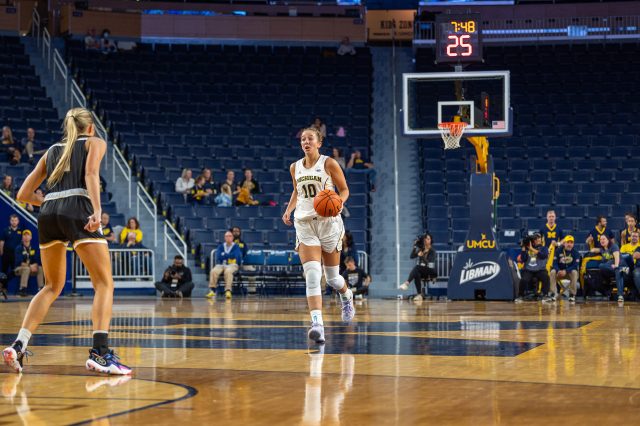[ad_1]
Long gone are the days of Naz Hillmon, Emily Kiser and Cameron Williams.
For years, the Michigan women’s basketball team took a post-centered approach, playing through the low block offensively and relying on a strong rim protector on defense. This season, however, the Wolverines’ style of play will look vastly different. Without a player over 6-foot-3 with meaningful Power Four experience, Michigan’s lineups will mostly feature guards and wings, pushing it to play a brand of basketball that capitalizes on skill and athleticism.
“We have a lot of versatile players, which I think is going to make us a very well-rounded team,” senior guard Greta Kampschroeder said at Big Ten Media Day Oct 2. “…We don’t necessarily have the same true centers that we did in the past, but (Wolverines coach Kim Barnes Arico) has done a great job adapting.”
Offensively, Michigan will play through its guards, with senior guard Jordan Hobbs as the centerpiece. After averaging nearly 10 points and a team-high three assists per game last year as a primary point guard, Hobbs will likely spend most of her time off the ball this season, freeing her up to take more of a scoring-focused role.
At Big Ten Media Day, Arico hinted that freshman guard Mila Holloway will likely be the Wolverines’ primary ball handler this year. And whether it’s freshmen guards Olivia Olsen and Syla Swords, or a combination of returnees and transfers that fill out Michigan’s starting lineup, the Wolverines will rely more on their guards than in years past.
Having multiple ball handlers on the floor — which Michigan’s roster construction allows for — is beneficial for a young squad. Acting as a primary ball handler is a tall task for a true freshman, but the Wolverines will always have additional ball handlers on the floor to take the load off of Holloway. At times, Michigan can employ a point guard by committee approach, rotating between their freshmen guards while leaning on Hobbs for stretches.
“I’ve been trying to put (Hobbs) in our backup point guard position a little bit this year,” Barnes Arico said. “She prefers not to because she wants to score the ball all the time, but I see her as someone that’s such a great playmaker.”
The most obvious advantage the Wolverines’ abundance of guards brings to the table is shooting. Hobbs shot 38.7% from beyond the arc last season, yet she recently declared Kampschroeder to be Michigan’s best shooter. Beyond the two veterans, Olsen, Holloway, and Swords are all competent shooters. After struggling to maintain consistency shooting the three last year, the Wolverines now have various options to provide a spark from outside.
Beyond the threat of raining threes on its opponents, Michigan’s improved shooting should benefit its slashers as well. When matched up with a shooter, a defender must stay with their matchup instead of moving towards the lane, preventing them from clogging driving lanes and disrupting opponents attacking the basket. Any defender who leaves their matchup runs the risk of allowing a 3-pointer. With better spacing, it should be easier for the Wolverines to attack the basket, and Hobbs has already noticed a difference in practice.
“When you drive, people have to help in, so a shooter is going to be open,” Hobbs said. “Then you can get ball movement and create scrambles, which is what we really want, and then you can get an easier shot.”
On the defensive end, Michigan’s shorter roster leaves it without much rim protection. While 6-foot-5 junior center Yulia Grabovskaia could fill this role, it remains to be seen how much she can contribute in the Big Ten after averaging just 10 minutes per contest for Middle Tennessee last year. The Wolverines lack a true center, making it easier for opponents to finish at the rim and hound Michigan on the offensive glass.
To overcome its size limitations, the Wolverines look to lean on the defensive advantages their versatile roster brings. Michigan doesn’t have a defender that opponents can pick on in pick and rolls. In these situations, the Wolverines can switch one through four, preventing opposing ball handlers from turning the corner on a hedge or creating space against drop coverage. Further, Michigan can switch on most off-ball screens, preventing opponents from running sets to free up drivers and shooters.
“We have the ability to switch positions,” Arico said. “…We’re going to change things defensively because of who we are. We’re going to play to our strengths.”
The Wolverines will have to play to their strengths upon adjusting to a new, uncharacteristically small roster this season. And that means embracing their shooting ability, versatility and length on both ends of the floor.
Related articles
[ad_2]
Source link











